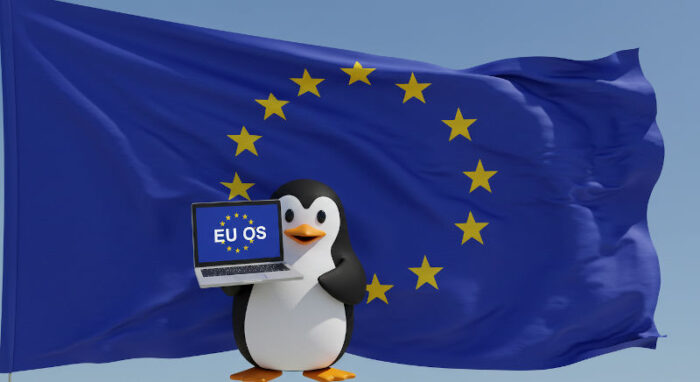So far it’s just a proof-of-concept, but it wants to grow up to be a layered — or modular — Linux distro that can become the workhorse of the European Union.

It may have started with LiMux – the Linux distribution created by the city of Munich, Germany in 2004 to fight Microsoft’s domination – and other distributions like GendBuntu, used by the France’s National Gendarmerie since 2008.
But as things grow to a multicultural size, EU OS has become an idea that could take over the continent of Europe.
The hatchling distro, which currently is based on Fedora Linux, is not yet really a distro at all but the proof-of-concept of a Linux-distribution-to-be, using KDE Plasma as a desktop environment, that hopes to one day grow up to be deployed in garden variety public sector organizations. The fact that it’s currently half-baked and not really all that operational is part of the plan.
“EU OS wants to confront the public sector with something already half-done to demonstrate that they can adopt Linux in practice,” Robert Riemann, the project’s principal developer told FOSS Force in an email. “For this, EU OS develops with the community a proof-of-concept.”
Riemann seems to be a natural for the project, being he’s both technically proficient and something of a bureaucrat. He’s been employed by the European Data Protection Supervisor’s office for more than seven years — currently as the head of sector Digital Transformation. While the EDPS acts independently of the EU it still has official status, as the supervisor is appointed by the government. He also says on his website that he’s “passionate about open source and free software, cryptography, data protection, big data analysis, modern web development, and peer-to-peer technology such as BitTorrent or Blockchain/Bitcoin.”
In other words, there doesn’t seem to be much mystery about why he’s put himself in this position.
He says that at this stage the plan is to get the EU government folks to look at what’s being put together, and if they like it, let them decide how it should be further developed to turn it into something suitable for EU bureaucrats. In theory, it will provide the EU a common Linux distribution as a base for all public-sector computer users, and will ship with options to layer on top modifications, such as a national layer, regional or sector-specific layer, organization-specific layer… the list goes on.
It’s going to be immutable — that is, the core file system will be read-only meaning the base operating system won’t be able to be altered by users or apps. That probably explains the current choice of Fedora as its base, since Fedora has Silverblue, an immutable variant of its workstation. Making EU OS immutable only makes sense, because governments everywhere need their IT infrastructures to be as stable — and more importantly, secure — as possible.
Another reason for choosing Fedora — a choice that several news sites have questioned since Fedora is controlled by US based Red Hat, a subsidiary of IBM — is support. According to the project’s website, at the beginning of the distro’s official deployment, when its user base is small, it may be necessary to contract commercial support for maintenance, which shouldn’t be an issue with a well known distro such as Fedora as base.
The distro’s also going to need to be available in multiple languages, because Europe doesn’t speak with a common tongue. That won’t be a problem, according to Riemann.
“Most free software– such as LibreOffice or Firefox — are available in all EU languages,” Riemann said, adding that the working languages of European Union institutions are English, French, and German. “The ambition of EU OS is to propose a migration that in itself is a larger undertaking. Adding one more language to some software that for some reason are not yet translated would be a minor issue given the entire project.”
Another question is how well EU OS will mesh with already established public sector computer infrastructures in the EU, which includes regions that default to Linux and well as regions where Windows remains the default? We wondered if they will readily migrate, and will they be able to do so with ease?
“Existing Linux projects would certainly have an easier migration path to EU OS,” Riemann said. “However, there is no urgency as they’ve achieved and already control and have sovereignty to a large extent. More importantly would be to convince current Windows users to switch to Linux. Here, the migration path is more difficult, but the benefits would be higher in terms of control and sovereignty.”
In this case, “sovereignty” means the user — in this case the EU — has outright ownership of the software, which is always true with open source software but never true with proprietary platforms such as Windows. This sort of software sovereignty that Linux and open source offers also makes it easier to maintain ownership of the data being processed.
“EU OS promotes to maintain strict control on business data and telemetry data,” he said. “This includes the free choice of where to store such data, (whether) on-premises or in a cloud of choice. Furthermore, the availability of know-how for a given FOSS component within the EU shall be considered.”






